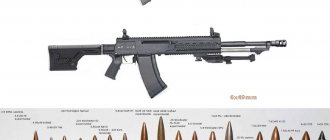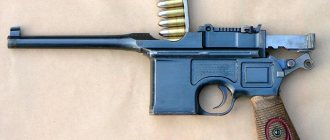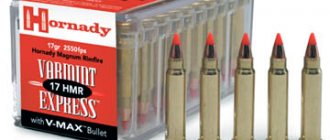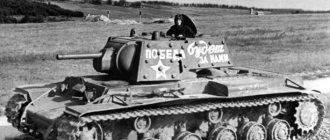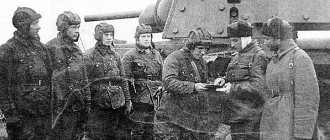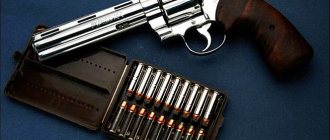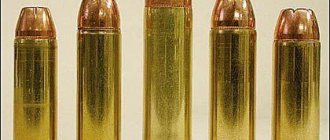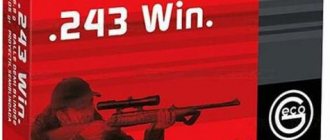Cartridge 8x68S / 8x68mm RWS
| 8x68S |
The 8x68S cartridge is designated: 8x68 S / 8x68 S RWS MAGNUM RIMLESS / DWM 654 / SAA 4630 / XCR 08 068 BGC 011.
8x68S
The 8x68S magnum cartridge is believed to have been created by Von Hoffe in 1938. Some sources suggest that this ammunition was originally created for use in light anti-tank rifles, but due to the rapid increase in armor, the cartridge was not used to fight tanks.
The 8x68S cartridge began to be mass-produced in 1940 by the German company RWS for the Mannlicher-Schoenauer rifle and became popular among hunters, especially after the end of World War II, when Germany rebuilt its industry.
Like all German 8 mm cartridges, this ammunition was originally loaded with bullets of two diameters: the older initial version (8x68) with a bullet with a diameter of 8.08 mm, and the second, final version (8x68S) with a bullet with a diameter of 8.2 mm .
The 8x68S cartridge has a beltless bottle-shaped case, a maximum bullet diameter of 8.22 mm (.323″), sleeve and cartridge lengths of 67.5 mm and 87.00, respectively (usually a length of no more than 85.85 mm), permissible pressure 380 MPa. Equipped with bullets ABC, H-Mantel, Kegelspitz, H-Mantel-Kupfer, Nosler Maccon 11.7-14.5 g with a charge of IMR4831 gunpowder of about 4.4 g, initial speed and energy respectively 870-990 m/s and 5496- 5748 J.
8x68S
Hirtenberger factory cartridge with a Nosier Partition bullet weighing 13.0 g and a charge of IMR4831 powder of 4.30 g, has an initial speed and energy of 910 m/s and 5383 J, respectively, and a powder gas pressure of 3800 bar.
When shooting at the optimal zeroing distance for this cartridge - 190 m, the bullet deviates from the aiming line no more: at a distance of 50 m - +1.0 cm, 100 m - +4.0 cm, 150 m - +3.0 cm, 200 m - -0.5 cm, 300 m - -23.8 cm.
The disadvantages of the 8x68S include sharp and painful recoil, as well as a relatively small selection of cartridges, produced only by Dynamit Nobel and Hirtenberger.
The 8x68S cartridge is intended primarily for long- and even ultra-long-range shooting. It is in the same class of weapon as the .338 Winchester, although its bullets are slightly smaller in diameter and lighter in weight. The energy of the 13 gram Nosier Partition bullet of this Hirtenberger cartridge exceeds that of the 17.65 gram bullet of the .375 H&H Mag cartridge. at all distances over 100 m. Some experts try to compare this cartridge with the .300 Weatherby Magnum and the .300 Winchester Magnum, but the 8x68S is much more powerful.
The 8x68S cartridge is suitable for hunting the largest animals in Russia at distances of up to 300 meters or more. The cartridge is long-range and, to a certain extent, narrowly targeted. At distances of about 100 m it severely crushes game.
| 8x68S |
Rifled cartridges: Which caliber is better? Which caliber should I choose?
Perhaps the most frequently asked questions that a hunter has to deal with are “Which caliber to choose?”, “Which caliber is best for hunting?”, “Is there a universal caliber?” etc.
Let's talk about this topic.
Can a “universal caliber” be universal for most hunts conducted? Almost everyone involved in the issue under discussion will probably say no.
It’s probably no coincidence that on any hunt you’ll almost immediately hear: “What kind of rifle do you have?” and “What caliber are you?” At the same time, everyone will convincingly prove that their Blaser, Mannlicher, Merkel, Remington, etc. chambered for .308 Win, .300 Win. Mag., 9.3x62 or the good old Mauser caliber 8x57 is what you need. The main thing is, do not try to convince them otherwise, because they have personal experience behind them, confirmed by sweat and blood, as well as successful hunts with wonderful trophies. There will definitely be someone who will modestly point out that with a simple rifle chambered for the domestic 7.62x54R caliber cartridge, he managed to obtain the entire line of European fauna.
Perhaps he is right too. But what about the fact that one weapon with a large caliber works perfectly well somewhere in the thicket, short distance, but turns out to be completely useless in mountainous areas? And vice versa, a 7x64 cartridge with an 8-gram bullet could not, say, stop an attacking 200-kg wild boar in its tracks? And finally, is hunting with such a heavy African “shaft” as a carbine of .458 Win caliber justified in our conditions? Mag., for example, for elk or bear? I’ll answer right away that no. And not at all because the caliber is large (11.6 mm). Americans say that there is never too much power. The point is completely different. Such weapons are bulky and clumsy, and therefore inconvenient for shooting offhand. It’s one thing if an elephant, buffalo or rhinoceros suddenly appeared in front of you in the tropical forest, but it’s another thing if a wild boar rushes at you from a short distance, when you need to shoot instantly and the target is much smaller in size than African giants.
If we have already touched on the African topic, then let’s ask what indisputable authorities say about the appropriate caliber. In hunting circles, the name of such a hunter as Craig Boddington is widely known, who in his book “Classic Hunting Cartridges”, in particular, writes: “If I were given a choice of only two cartridges for hunting “everything in the world”, then I would preferred to get the .30-06 and .375 H&H. But if the choice were limited to one cartridge, then the answer would be “.375”.
In relation to Africa, I remember another statement by the famous professional hunter from South Africa, Albert Alberts. He is deeply convinced that with a carbine in .416 Rigby caliber, you can safely travel all over Africa from Sudan to Cape Town, successfully hunting any animal. By the way, it will be said that in the reputable edition of the American directory of hunting cartridges AMMO & BALLISTICS by the famous author Bob Forker, there is an entire section describing cartridges intended for “dangerous hunting”. As you may have guessed, the .375 H&H Magnum cartridge is not mentioned at all, but twenty-three other cartridges are mentioned, ranging from the .400 A-Square to the .700 Nitro Express.
In order to somehow move forward in our search for truth, let's start from another important criterion: what are the most common calibers in the world?
An analysis of the prevalence of cartridges shows that the first place in the world is occupied, and by a large margin, by a group of calibers with a bullet diameter of 7.62 mm, also known as .30 and .300. It is in this group that there is the greatest variety of calibers. These include the very popular .308 Winchester and the .30-06 Springfield, which is remarkable for its versatility. Judge for yourself, the cartridge is equipped with bullets weighing from 8 to 14.3 g with sufficient energy, about 4000 joules, which allows it to be used on a wide variety of hunts.
.300 Win. Mag. – he really is a “jack of all trades.” The .300 Weatherby Magnum, however, will be a little better and more interesting, especially for African and mountain hunting. We can say that the .300 Win. Mag. Its capabilities fall between the 7mm Remington Magnum and the .338 Win. Mag.
The same group includes the German cartridge .30 R Blaser (7.62 mm x 68 R), which is produced for rifles and combination shotguns. Its power is on average 8% higher than that of the .30-06 caliber cartridge. .308 Win, .30-06 Sprg, .30-30 Win, .300 Win.Mag., .300 RCM, .300 Savage, .300 Weatherby Magnum, .300 Whisper, .300 WSM and this is not a complete list of calibers who are included in this group.
However, in relation to hunting practice, not everything is so smooth: according to experts, wounds inflicted by bullets of 7 mm and 7.62 mm calibers, as a rule, close quickly, therefore blood may not be detected at the scene after the shot, which in the absence of snow can even lead to to the loss of a wounded animal. At the same time, wounds caused by bullets of calibers over 8.5 mm (.338) almost never close and leave behind a fairly visible mark.
Until recently, most experts recognized that the lethality of any 7.62 mm cartridge against dangerous or large animals was not sufficient. The controversy continued even after the advent of powerful 7.62mm magnum calibers such as the .300 Win. Mag., .300 Weatherby Magnum, .300 Remington Ultra Magnum, 30-378 Wby and especially the .308 Lazzeroni Warbird with muzzle energy up to 6700 joules!
The fact is that with the advent of powerful high-speed magnum calibers, a wide range of solid bullets with the so-called controlled expansion did not immediately appear: CDP, Orix, Swift-A-Frame, Fail Safe, Woodleigh, etc., while simple semi-jacketed bullets at a speed of about 900 m/s, the bullets literally “exploded”, causing extensive superficial wounds. Compared to them, heavy bullets of 9 mm caliber and above with lower speeds killed game faster and more reliably. The situation has changed over time.
High-speed and harder 7.62 mm magnum-caliber bullets, as well as the German 8x68S cartridge with a bullet weighing 14.5 g, began to represent a formidable force that affected all European animals, as well as all African antelopes. Some hunters also shoot lions in Africa with weapons chambered for these cartridges, although I would still recommend the .338 Win. Mag. or .375 H&H Magnum. At the same time, if we open a modern catalog of German RWS cartridges, we can find that the 8x68S cartridge with a KS bullet weighing 11.7 g has truly monstrous energy - 5734 J! This is even more than the .375 H&H Magnum cartridge with a UNI Classic bullet weighing 19.4 g and with an energy of 5677 J (data from the same catalog). The cartridge is suitable for hunting elk and bear. From personal experience I can say that I compared the performance of the 8x68S cartridge with the .300 Win cartridge. Mag. and the first one definitely works better.
What then is the reason for its less popularity? Firstly, it is produced by only two European companies, and secondly, the selection of bullets, especially modern ones, is small. To put it more bluntly, the problem with the cartridge is that it is not American. It is close in performance to the .300 Win. Mag. and cannot compete with it in terms of the prevalence and variety of equipment with bullets of modern designs. In addition, even in the German catalog the cost of the .300 Win. Mag. on average lower than that of the 8x68S cartridge. I would like to note that well-known German experts, such as, for example, Manfred R. Rosenberger, admit that all the latest German bullet developments are not truly innovative. By the way, the German CDP bullet known to our hunters is no better than the American analogue Partition Gold, and the widely advertised Evolution bullet does not have a good stopping effect. I will refer to my own experience. I shot two boars weighing 100 kg and 120 kg with a .30 R Blaser cartridge with an Evolution bullet, weighing 11.9 g. In both cases, both lungs of the animals were pierced, but the boars ran 70 and 150 m, respectively. The exit bullet holes were small . In a similar situation, hunting wild boar with the same caliber, the KS (half-jacket) bullet, weighing 13 g, turned out to be much more effective. To be objective, the Evolution bullet is good in accuracy and has less wear on the gun barrel thanks to its special coating. Still, it is more suitable for shooting at long distances and at animals like deer. The fact that the KS bullet has a better stopping effect than the Evolution can be seen based on the data in the table compiled by RWS itself.
Conclusions we can come to.
We have touched upon a topic that has been discussed in the hunting press for decades without any chance of ending. The reason is the huge variety of hunting weapons and ammunition. And yet, if you can afford to buy only one rifle, then based on the combination of advantages, characteristics and price, it will be a weapon chambered for .300 Win. Mag., .300 Weatherby Magnum or 8x68S cartridge. For those who like a combination weapon, it's chambered in the rimmed .30 R Blaser.
I would like to draw your attention to the fact that the Silver Selection cartridge cal. .300 Win. Mag. RWS even recommends the Uni Pro 11.7G for buffalo hunting, meaning we are talking about a truly universal cartridge. Those who have hunted in Africa know very well that there are only two types of rental carbines available everywhere: the .300 Win. Mag. and .375 H&H Magnum.
In our conditions, larger calibers, such as 9 mm, are more successful against large animals, but are of little use for long-distance shooting, which makes them, although effective, highly specialized weapons, that is, not so universal.
For pure woodland hunting, where shooting distances rarely exceed 100 m, even larger calibers such as .45 Blaser, .444 Marlin, .450 Marlin and 45-70 Government work better. The bullets of these cartridges have another important property: their low velocity produces less ricochet, in addition, they spoil meat to a lesser extent compared to their magnum counterparts.
We can talk about this topic for a very long time, because we haven’t even touched on the recently popular 6.5 Creedmoor, or the no less interesting 6 mm and 7 mm. And there is something to talk about...) We will definitely touch on this topic next time.
And in conclusion, a wish that was jokingly expressed by a friend of mine from the African continent: “The main thing when hunting is to walk more quietly and shoot louder.”
Alexander Torgashin (an experienced hunter who has captured trophies of the Big Five and many other animals) expressed his vision.
6.8 mm cartridge: what is behind the numbers?
So, in the previous article we went through (maybe not in such detail) rifles that are “tomorrow”. Which should replace the modern caliber 5.56 mm (and possibly 7.62 mm) with 6.8 mm.
To replace the M4 in the US Army: not the HK416! October 23, 2022 21 943 71.
Now it's time for the cartridges. After all, such a simple thing as a cartridge is a serious component in any army in the world. And it’s not as simple now as it seems.
We will start with the table that was already posted in the above material.
Here, year by year, it is perfectly described when, what ammunition will be given time and (probably the most important thing) money. It’s probably worth introducing the participants to make it clearer.
Combat Projectile - combat ammunition.
Reduced Range Ammunition (RRA) – training ammunition.
Combat Tracer - combat tracer.
RRA Tracer – training tracer. Training, if we understand correctly, with a reduced powder charge, since the literal translation of RRA is reduced-range ammunition.
CCMCK is a training kit for training in conditions close to real ones.
This ammunition will become the object of close attention, because it raises a mountain of questions for us. And we will certainly return to it. In the meantime, here is a video that explains the mechanics of the SSMSK; it makes it clear why we were so excited.
Well, now let's go to the ammunition.
The fact that the guys at Devcom are not stupid is beyond doubt. The plan for developing an innovative program for re-equipping a US Army soldier is beautifully written and takes into account all aspects of preparation and application.
All companies participating in the competition fulfilled the order for new ammunition. Now we will try to understand in more detail what the best gunsmiths in the world came up with.
Conventionally, all presented cartridges can be divided into two main categories - hybrid and telescopic.
Hybrid ammunition:
Its distinctive feature is a two-component sleeve, which consists of a metal primer, a base and a polymer sleeve body.
It is difficult to say what specific polymer is used in production; naturally, all this is kept in the strictest confidence by the manufacturers. But if you delve into the relevant literature, you can draw some conclusions.
Plastics with a high melting point include fluoroplastic and polyamides, as well as heat-resistant Niplon plastic. For example, the melting point of fluoroplastic is 327°C (for fluoroplastic-4 and 4D). Polyamides (caprolon, caprolit) have a softening point of 190-200°C, and the melting point of such plastic is 215-220°C. Glass and carbon fiber Niplon has a melting point above 300°C.
Of the variety of polymers, plastics based on organosilicon resins are suitable for use at high temperatures. The maximum operating temperature of such plastic can reach 700°C, which in principle is quite suitable.
Again, in addition to temperature conditions, it is also necessary to combat the expansion of powder gases, which, in addition to heat resistance, also adds strength problems. For some reason, no one wants to see a swollen cartridge case in the bore after shooting.
However, we can say with confidence that it is not cheap, not cheap at all. Of course, in the pursuit of weight loss, the issue of price fades somewhat, but with the same success you can roll cartridges from evergreen pieces of paper with presidents.
Telescopic chuck:
That's true, it resembles an “innovative” ammunition. In the previous article we showed his work.
Of course, the operating principle of such a weapon leaves a lot of questions. Although, if you look at it from the other side, you get only one moving part that does not carry an axial load. Looks quite reliable. And the recoil seems funny, because now half a kilogram of iron doesn’t hit you in the shoulder when you fire.
The system is interesting precisely because it combines German developments of a caseless cartridge, where the bullet is embedded in a powder charge. There was such a development on the prototype rifle of the future G11.
In the new cartridge, the primary propellant charge “deliveries” the bullet, while the secondary one already accelerates it. Well, there was a time when we joked about “pocket artillery”... Apparently, that time has come.
Please note that the case size 7.62 and 6.5 (later changed to 6.8) are identical.
This suggests that the element of modularity, beloved by NATO, has not gone away, and now, after simply replacing the barrel to the required caliber, you can get a more powerful rifle or even a “marksman”.
But for a machine gun this is generally a standard procedure.
The telescopic chuck looks more preferable for use, as it is more innovative and has fairly balanced performance.
Now let’s talk about what changing not only the ammunition, but also the caliber entails.
Rearmament is a costly business, new weapons, new ammunition. A wider and longer cartridge needs a longer and wider magazine. And as the magazine size changes, we begin to think about the size of the pouches. If you estimate even by eye, it becomes clear that a standard pouch for a 5.56 x 30 magazine, which could be used for two magazines, can now only handle one 6.8 * 30.
Of course, a country with such a budget for the army dresses its soldiers in modular systems with the ability to change pouches. But there are also full-fledged vests that will have to be abandoned. Or, as an option, sew new ones.
Verdict.
At first glance, the program for changing caliber, cartridge and rifle/light machine gun looks very expensive. But then such an interesting dependency diagram may appear that even the US Army budget will tremble.
The German rifle and machine gun cartridge, which went through two world wars, was undeservedly forgotten in the post-war period. Its revival in Russia was facilitated by the appearance on sale of captured German Mauser 98k rifles in the early 2000s. However, there is a small but stable demand for weapons chambered for this cartridge. Why is he interesting?
The 8x57IS cartridge still remains relevant for hunting ungulates. It has moderate recoil, while its stopping and killing effect is quite sufficient to kill even the largest animals in modern Europe - elk or bear. I have seen many times how an elk falls almost on the spot from the first shot with this cartridge, without requiring additional retrieval. The excellent combination of high bullet weight (12.7 g), average speed (770 m/s) and a slightly larger than usual 7.62 mm caliber makes the 8x57IS cartridge one of the best medium-caliber rifle cartridges for manhunts.
Patron history
I will not go deep into the history of the appearance of 8x57 IS, I will only note that there are two different, non-interchangeable, calibers - 8x57I and 8x57 IS. The letter I in the index means Infanterie (“infantry”). The 8x57I cartridge appeared in 1888 and became the world's first cartridge with smokeless powder and an annular groove. The caliber in the fields is 7.9 mm, in the rifling 8.09 mm. In 1903-05 the cartridge was modernized. The bullet became pointed, the caliber increased to 7.92/8.22 mm. This is why cartridges are not interchangeable. The letter S was added to the index - from Spitzgeschoss (“pointed”). Both cartridges have a pair in the form of a cartridge with a sleeve that has a rim (8x57 IR and 8x57IRS, respectively).
We are now considering only 8x57 IS, which also had the designations 7.92x57, 8 mm Mauser, Patrone 88/S, 7.92 M88/05, M.88/8 SI. Traditionally, military-type cartridges are designated as 7.92x57 mm, and civilian - 8x57 mm. It is allowed to replace the letter I with J (jagd - hunting) in the name of the cartridge. Although, there is another explanation that this is simply confusion due to the similarity of the spelling of the letters.
During the period between the two world wars, the cartridge became one of the most common among hunters in Europe. But, after World War II, its popularity began to decline around the world due to the fact that its main competitor, the American .30-06 Sprg, was more affordable and could be bought in almost any possible equipment. And Germans were banned from the market for several years by administrative measures. However, the huge number of Mauser 98 rifles remaining after the war, especially in Europe, allowed it to remain in production to this day.
Read the history of the British 7.92 BESA here
Comparison with analogues
The closest analogues of the 8x57IS cartridge are the .30-06 Sprg and our Mosin rifle cartridge 7.62x54R, which were its direct competitors during the two world wars. We will compare modern ammunition produced by the Czech company Sellier&Bellot with FMJ bullets of all three mentioned calibers.
From left to right: 30-06 Sprg, 8x57IS and 7.62x54R
Bullet speed at distances, m/s
| Cartridge | Handlebar weight g/grain | V0 m/s | V100 m/s | V200 m/s | V300 m/s |
| 7.62x54R | 11,7/180 | 786 | 725 | 669 | 617 |
| 8х57IS | 12,7/196 | 789 | 735 | 685 | 638 |
| .30-06 Sprg | 11,7/180 | 815 | 760 | 709 | 661 |
Bullet energy, at distances, J
| Cartridge | Handlebar weight g/grain | E0 J | E100 J | E200 J | E300 J |
| 7.62x54R | 11,7/180 | 3614 | 3075 | 2616 | 2226 |
| 8х57IS | 12,7/196 | 3953 | 3430 | 2977 | 2583 |
| .30-06 Sprg | 11,7/180 | 3886 | 3379 | 2938 | 2555 |
The tables show that the 8x57IS cartridge is a complete analogue of the American .30-06 Sprg. True, the latter also has more powerful equipment with 5-10% higher energy and greater bullet weight.
The domestic cartridge 7.62x54R is somewhat inferior to the 8x57IS in terms of characteristics (by about 10%) and bullet weight. In addition, the domestic cartridge does not produce such a variety of types of bullets as the 8x57IS.
The ballistics of the 7.62x54R and 8x57IS cartridges are generally similar; the .30-06 Sprg has less bullet drop at longer distances.
Absolute reduction of bullets at distances, cm
| Cartridge | Handlebar weight g/grain | 50 m | 100 m | 200 m | 300 m |
| 7.62x54R | 11,7/180 | -0.3 | 0 | -13.7 | -49.4 |
| 8х57IS | 12,7/196 | -0.4 | 0 | -13.2 | -47.4 |
| .30-06 Sprg | 11,7/180 | -0.5 | 0 | -12 | -32.2 |
Range of cartridges from modern manufacturers
The production of commercial 8x57IS ammunition is now limited mainly to European companies. Below I have made a short review of the cartridges available in the Moscow region. Prices are given for the beginning of 2022.
The widest range of cartridges of this caliber is available from the Czech company Sellier & Bellot . In addition to fully jacketed FMJs, their range includes the usual SP half-jacket, as well as proprietary SPCE (sharp edge half-jacket), HPC (expansive bullet with a copper cap, which combines the lethality with the accuracy of jacketed bullets). All bullets are 12.7 g. Prices for cartridges are about 150 rubles per 1 piece.
Serbian
PPU / Partizan .
After the war, Yugoslavia adopted a number of German weapons, including the Mauser 98k rifle and MG-42 machine gun, which used 7.92x57 mm cartridges. You can also recall the 7.92 mm Zastava M76 sniper based on the AK. Accordingly, Yugoslavia also produced ammunition. Now Serbian cartridges are the cheapest imported ammunition of 8x57IS caliber with a price of about 120-130 rubles per piece. The most interesting type of ammunition from the Serbian manufacturer, in my opinion, is ammunition with the Grom bullet. It is made of a copper alloy; a small hole is made in the toe of the bullet into which lead is poured. The bullet is somewhat similar to the Finnish MEGA from Lapua. The design of the bullet allows you to maintain the maximum weight of the bullet after hitting the target. Bullet weight is 12 g. There are HP hollow point bullets weighing 11.34 g.
Another noteworthy cartridge from the Serbian company PPU is the FMJ BT bullet weighing 250 grains or 16.3 g (!!!). The low initial speed - 660 m/s - in combination with the large mass of the bullet should give a good stopping effect in driven hunts. It is a pity, however, that it is not a half-jacket or other bullet with controlled expansion that is used.
8x57IS cartridges have always been popular in northern Europe, Sweden and Finland. Finnish cartridges (Sako, Lapua) became unavailable on the Russian market after the start of sanctions; only Swedish Norma . These are the classic 12.7 g bullets Oryx, Vulkan, Alaska, as well as the jacketed light (8 g) Jagd Match. The price for these high-quality cartridges is very high - 320-400 rubles per piece.
German manufacturers are represented by two brands - RWS and Geko. RWS offers a selection of its classic bullets - EVO, ID, HMK, H-mantel and a number of others. The prices for these cartridges are even higher than for Swedish ones (more than 400 rubles per piece) and have recently almost disappeared from sale. Geko cartridges (a budget brand of the RUAG concern, which also includes RWS/Rottweil and Norma). Now on the Russian market there is a TM Geko half-shell (12 g) with a reasonable price of 180 rubles/piece.
FMJ problem and the new Tekhkrim cartridge
Recently there has been a problem with the supply of cartridges in ammunition with a fully jacketed FMJ bullet. They are supplied in very small quantities and are immediately sold out. Despite the fact that the 8x57IS cartridge is purely a hunting ammunition, the need for FMJ equipment is necessary for a number of reasons. For example, for zeroing a weapon, it is better to use a cheaper cartridge with a bullet of the same mass as for hunting. Control shooting also requires fully jacketed bullets. Finally, for some types of hunting it makes more sense to use an FMJ rather than a half-shell.
In Russia, cartridges of this caliber have never been produced, but after the start of sanctions and the devaluation of the ruble, the question of a domestic analogue of the 8x57 IS became acute. The first company to pay attention to this problem was Izhevsk. In 2022, the first batch of 8x57 IS cartridges with a 12.8 g FMJ bullet was produced. The muzzle velocity of the bullet was 760 m/s. Interestingly, the packaging of these cartridges includes 5 pieces, which is very correct - not everyone needs a standard 20-round cartridge, especially considering the cost of the ammunition.
The history of the appearance of these cartridges is interesting. The deployment of production of a new cartridge, atypical for Russia, requires large capital expenditures - the purchase of machines and equipment. For the relatively small number of 8x57IS weapons on hand, there is no need for millions of “circulations”, and the payback of new equipment can only be achieved at a certain level of production.
"Techkrim" solved the problem of small-scale production very elegantly - for the production of 8x57IS, "disassembled" German ammunition, which was in military warehouses and now written off as unnecessary, is used.
Only brass sleeves manufactured in 1939-1942 are selected for production.
The first to be put into operation were cartridge cases that did not have markings on the bottom. On the bottom of the remaining cartridges, the original markings are retained; additional markings (the company logo and the designation of the 8x57IS ammunition) are applied to the side of the cartridge with a laser.
From a wide variety of manufacturers (Romania, Greece, Belgium), only original German cartridges are used. By the way, brass casings were used in the Wehrmacht exclusively for machine guns, in contrast to rifle casings, which were metal. This is due to the operation of their automation; machine guns had problems with metal casings during extraction.
The old capsules are removed and the imported KV-7.62, an export version, is installed instead. Why did you need to change the capsules? Firstly, old rusting ones contain mercury, which is very bad for non-chromed Mauser 98k barrels. Secondly, the degradation of primers that were produced 70-80 years ago has already occurred long ago; misfires in such cartridges are common. Therefore, the best solution was to change these capsules.
But the old German gunpowder turned out to be quite suitable and even in some ways superior to modern Russian ones! According to the old army manual on cartridges for foreign armies, this is “flat graphite powder Nz. Gew. Bl. P. (2.2. 0.45)".
The bullets that are used to load cartridges have a bimetallic jacket. This bullet in German nomenclature was classified as heavy type sS (schweres Spitzgeschoss). The bullet has a steel core, the bullet tail is narrowed (boat tail).
But the biggest sensation is its cost, which at retail is about 80 rubles/piece. This is on average 2 times lower than analogues.
Related articles:
Test with 5 Mauser 98k cartridges
History of Mauser 98k
